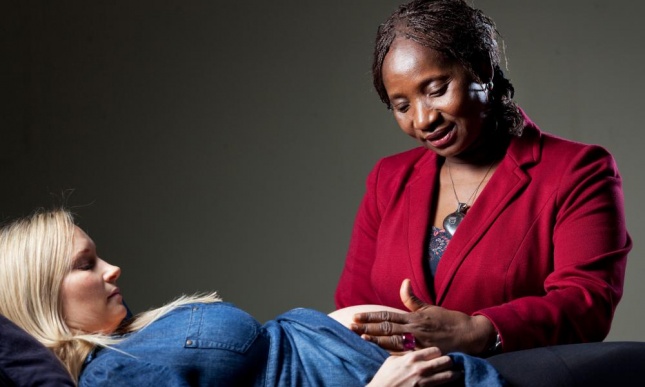
‘While midwifery care is based upon viewing pregnancy and birth as normal physiological life events, obstetric medicine is based upon treating pregnancy and birth as a medical procedure.’ Janet Fyle, midwife, examines mum-to-be Charlotte Olesen. Photograph: David Levene for the Guardian
Australia has one of the highest caesarean rates in the world. And it’s not good for us.
Last month, the World Health Organisation (WHO) warned that caesarean sections should only be performed when medically necessary – no more than about 10%-15% of all births. Above that rate, there is no evidence of improved mortality.
Ten years ago, Australia’s caesarean rate was 19%. Now, it’s a staggering 32%.
If increasing rates of surgical birth does not improve outcomes, and if caesareans cost public healthcare systems significantly more than low-intervention births, why are more than one in three birthing women now facing surgery? And what effect is this having on women?
Caesarean section is major abdominal surgery. Women who give birth via caesarean face increased risk of infection, admission to ICU, hysterectomy, haemorrhage or death. During the surgery women can suffer scalpel lacerations to bladders, bowels or other internal organs, and babies can also be cut. Medications and anaesthetics can be misused causing health problems. Recovery can be long and painful, and can involve infections, surgical staples overgrown with skin, the excruciating removal of wound drains, and other difficulties.
Birth by caesarean can interfere with breastfeeding establishment, affect an infant’s gut and future health, and increase a woman’s chance of repeat caesarean, putting her at further risk of potentially life-threatening complications such as placenta accreta (where the the placenta and blood vessels grow deeply into the uterine wall, which can result in severe blood loss on removal) and uterine rupture.
In Australia between 2006-2010 there were 39 direct maternal deaths. Twenty-six of these deaths were caused by amniotic fluid embolism, thromboembolism or obstetric haemorrhage. Of these 26 deaths, over half followed caesarean section. Only three followed a normal vaginal birth.
One in five Australian women now develop postnatal depression. Research has demonstrated a link between caesarean and increased risk of postnatal mental illness. Following childbirth, 3%-6% of women will develop post-traumatic stress disorder – that’s about 9 to 18 Australian women every day developing a level of trauma first diagnosed in soldiers returning from war. One of the highest causes of indirect maternal death in Australia is suicide.
Clearly, we are failing birthing women. So what needs to be done?
Leah Hardiman, president of Maternity Choices Australia, says:
A lot of issues would be resolved through continuity of care with midwives as primary carers. This has been proven time and again through studies and in practice.
While midwifery care is based upon viewing pregnancy and birth as normal physiological life events, obstetric medicine is based upon treating pregnancy and birth as a medical procedure. Obstetricians are surgeons, and surgeons excel at performing surgery. While midwives are paid to wait for labour to unfold and to act if necessary, obstetricians are paid to act.
So is it any wonder that when healthy pregnant women are predominantly managed by surgeons – as they are in Australia – rates of surgery are high?
Obstetric authorities often cite the rising age and bodyweight of birthing women, and women’s request, as the cause of increasing caesareans. However, researchers argue that where a woman lives and whether or not she has private health insurance are the greatest contributing factors to whether or not she’ll have a caesarean.
Birthing women often report feeling pressured, coerced, on the clock, and at times bullied into consenting to surgery. Women refer to the anecdotal “cascade of intervention”, describing a conveyor belt sensation: an induction gel leads to having her membranes ruptured, which leads to a drip, which leads to an epidural, which leads to “failure to progress” and being told that the only possible next step is caesarean.
Often, babies struggle with these interventions and foetal distress requiring emergency surgery results. Arguably, many routine interventions done in supposed help of women and babies are not actually helping at all.
As a result of burgeoning rates, caesarean has become normalised within our culture and its seriousness of is often downplayed. Women are placated with a false innocuousness of surgery, urged not to get their hopes up for a natural birth as they approach their due date, nor to chastise themselves if things don’t go to plan. While this attempted reassurance might be well meaning, the reality is women are adults capable of understanding facts and deserve to know where they are being grossly let down.
Undoubtedly there are instances where caesareans save lives. Skilled obstetricians are vital to our maternity care system. The priority of any health professional should be upholding women’s rights to bodily autonomy; any woman who makes an autonomous, informed decision to elect caesarean should have the unequivocal right to do so.
But women – and their care-providers – are not making choices in a vacuum. For a long time, medicine was a men-only sphere where women’s bodies were believed to be inherently flawed, and childbirth came to be considered an undignified, frightening and dangerous procedure to be endured and maybe survive. These patriarchal influences linger today.
Almost 900 women give birth in Australia each day. That’s roughly 300 caesarean sections. By WHO’s calculations only about 90 of these surgeries are likely to be necessary.
This means around 210 caesarean sections are performed every day in Australia unlikely to benefit those women, their babies, or the public healthcare system – and are likelier to endanger their health and wellbeing.
In our ongoing fight for women’s reproductive rights, reducing our caesarean rate to reflect women’s needs should be an urgent priority.
